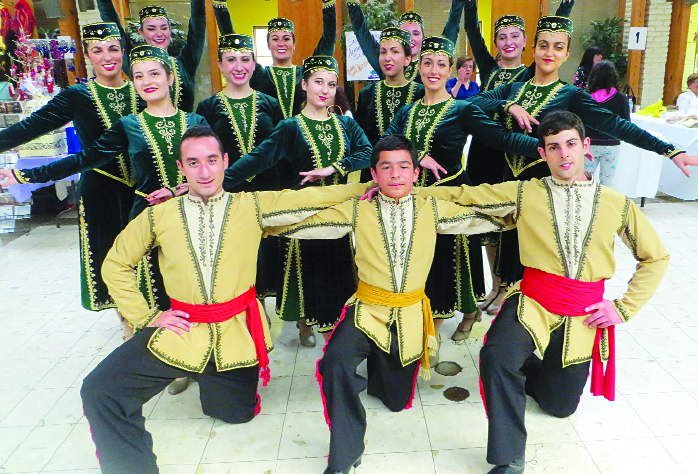
BY HILLARY VIDERS
SPECIAL TO NORTHERN VALLEY PRESS
TENAFLY, N.J. –– Wonderful food, winter gift items and whirling dancers were jubilantly on display at the St. Thomas Armenian Church’s Food Festival and Holiday Bazaar on Oct. 21 and 22 in Tenafly.
The Armenian Church was filled with Mediterranean flair and festive music, as hundreds of people strolled through the maze of rooms to find bargains. Over two dozen vendors had merchandise for sale. Many items, including jewelry and scarves, were hand made by Armenian crafts people.
[slideshow_deploy id=’899′]
There was also a “White Elephant” booth for shoppers who enjoy exploring vintage and non-vintage treasures and value-priced goods.
Edward Baykar Dervishian and his wife came all the way from Framingham, Mass., to sell Armenian clothing at the bazaar.
“I come to this festival every year. It is my hometown, and I love the people. It is such a welcoming community!”
Like Dervishian, many visitors travel quite a distance, from all over New Jersey as well as New York State and Connecticut.
“The Armenian community is very strong, close knit and welcoming, so everyone feels at home no matter where they’re from,” said Mary Ann Saraydarian, who has been treasurer of the St. Thomas Armenian School and a church volunteer for 48 years.
A 50/50 raffle added to the excitement of the two-day event. The winners were announced on Sunday afternoon along with the raffle drawing.
Children were delighted with nonstop activities led by teachers in the church’s school: a clown show, a magician performing tricks with a live rabbit, a bubble party, face painting, video games, air hockey and arts and crafts.
Food was a central part of the festival, reflecting its importance in Armenian culture. Young girls (and boys) become proficient cooks at an early age. So it was no surprise that the buffet at the festival was over-the-top delicious. For weeks, church members had been preparing delicacies handed down through generations, some of which cannot even be found in Armenian restaurants. The menu included exotic dishes such as manti, miniature boats of dough embracing a dollop of meat and prepared in chicken broth flavored with yogurt, garlic and sumac; kuftes, meat mixed with bulgur on the outside, encasing a mixture of meat, onions and spices cooked in chicken broth; and sou beoreg, 10 sheets of thin rolled dough, buttered and layered and baked with a cheese mixture.
Complementing the Armenian specialties were chicken, lamb and hamburger kebabs; rice pilaf and delicate pastries and cookies.
After guests loaded their plates, and often came back for more, they sat at large tables in one of the church’s spacious halls. Masis Parseghian, a hale and hearty 90-year-old, came to the festival with three generations of his family. At their table, he was surrounded by his wife, daughters and granddaughters. Parseghian is regarded as a folk hero by his family, because in 1986 he braved a climb to the top of Mt. Ararat, a 12,782-foot-high isolated mountain of volcanic origin, located in the extreme eastern part of Turkey near Iran.
On Sunday afternoon there was a dramatic dance performance by the famous Antranig Dance Ensemble. Fourteen young dancers did exciting routines that had them twirling, stomping and leaping in the air in sync. The company is directed by Joyce Tamesian-Shenloogian, who had danced for many years before assuming the helm a number of years ago. This current entourage includes her daughter.
Shenloogian is proud of the Antranig dancers, who work extremely hard and perform at numerous venues throughout the year, including Lincoln Center.
“Once a year we bring noted choreographer Gagik Karapetian to work with the dancers,” she said.
When asked why her dance troupe is so popular, Shenloogian said, “Armenians love this group because it preserves our culture. Armenia has a long history of being brutalized and occupied. These festivals and dance troupes are a testament to our resiliency and pride in our heritage. People who are not Armenian are amazed that Armenians still want to preserve these traditions, because there is so much assimilation in the world today.”
Preserving a heritage
Shenloogian’s observation about Armenia’s history is accurate. As far back as 1600 BC, Armenia was besieged by numerous tribes, nations and rulers that sought to annihilate the Armenian people.
Even as recently as the early 20th century, Armenians suffered genocide inflicted on them by the Ottoman government, in which 1.5 million Armenians were killed and many more dispersed throughout the world via Syria and Lebanon.
Armenia did not regain independence until 1918, with the establishment of the First Republic of Armenia, and in 1991, the Republic of Armenia.
[slideshow_deploy id=’899′]
Perhaps it is their hard fought freedom that makes Armenians so joyous in their modern day celebrations. The St. Thomas Armenian Church’s Food Festival and Holiday Bazaar is an example of how Armenians cherish their heritage and seek to share it with people everywhere.
Photos by Hillary Viders
